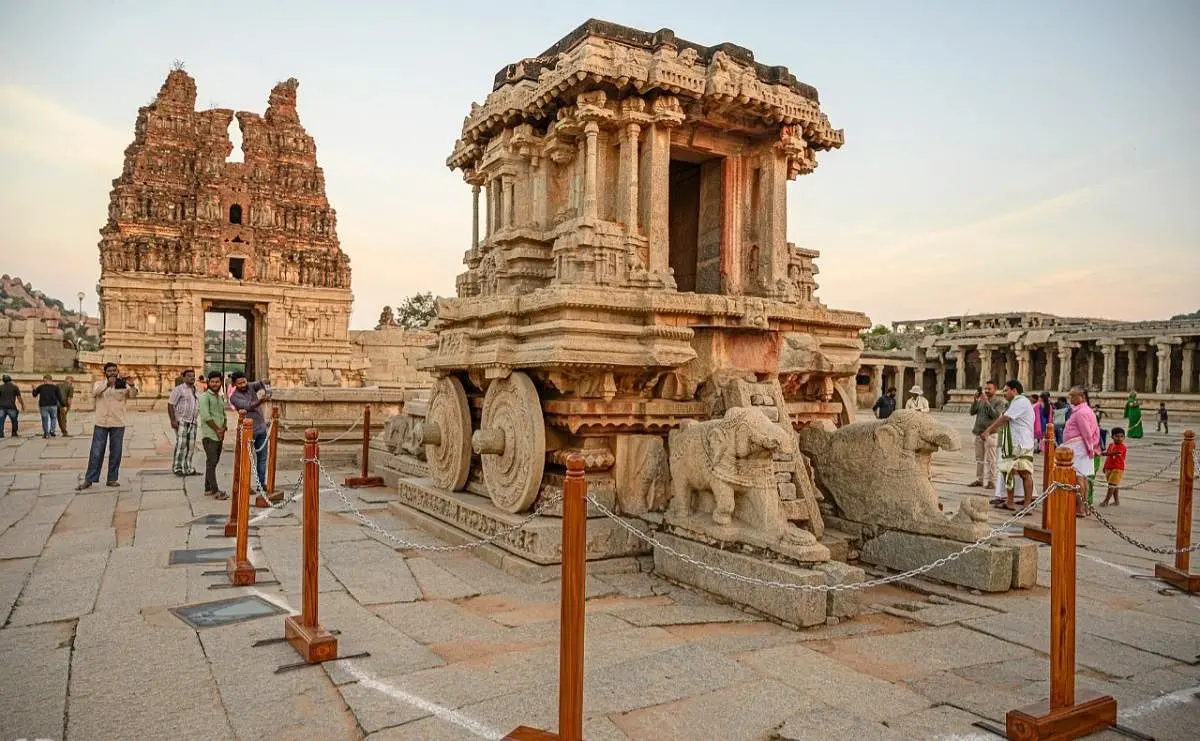Hampi is a UNESCO World Heritage Site located in the Indian state of Karnataka. It was the capital of the Vijayanagara Empire in the 14th century and is renowned for its extensive ruins, which include temples, palaces, and market streets, all set amidst a dramatic boulder-strewn landscape. Key attractions include the Virupaksha Temple, Vittala Temple, with its iconic stone chariot, and the Hampi Bazaar. The site is also known for its stunning sunrise and sunset views, particularly from the Hemakuta Hill and Matanga Hill.
Hampi, a UNESCO World Heritage Site in Karnataka, India, is renowned for its rich history, stunning architecture, and unique landscape. Here are some interesting things to do in Hampi:
Explore the Ruins of Vijayanagara Empire:
Visit the various temples, palaces, and market streets of the Vijayanagara Empire. Notable sites include the Virupaksha Temple, Vittala Temple (with its iconic stone chariot), and Hazara Rama Temple.
Climb Matanga Hill:
Hike up Matanga Hill for a panoramic view of Hampi. It’s particularly beautiful at sunrise and sunset.
Visit the Royal Enclosure:
Explore the royal buildings, including the Lotus Mahal, Queen’s Bath, and Elephant Stables.
Explore the Riverside Ruins:
Walk along the Tungabhadra River to see the ancient ruins and carvings, including the Sugriva’s Cave and Koti Linga.
Coracle Ride on Tungabhadra River:
Experience a traditional coracle boat ride on the Tungabhadra River for a unique perspective of the landscape and ruins.
Visit Anjaneya Hill:
Climb the steps to the Anjaneya Temple, believed to be the birthplace of Hanuman. The hill offers stunning views of the surrounding area.
Attend the Hampi Utsav:
If you visit in January or November, you might catch the Hampi Utsav, a cultural festival featuring music, dance, and processions.
Explore the Hippie Island:
Cross the river to the other side, known as Hippie Island or Virupapur Gaddi. It’s a laid-back area with cafes, guesthouses, and opportunities for bouldering.
Bouldering:
Hampi is a popular destination for bouldering enthusiasts. You can rent equipment locally and explore the granite boulders scattered across the landscape.
Visit the Archaeological Museum:
Located in Kamalapura, the museum showcases artifacts and exhibits from Hampi’s history.
Anegundi Village:
Explore this charming village, believed to be older than Hampi, with its quaint houses, narrow streets, and historical sites like the Ranganatha Temple and Pampa Sarovar.
Enjoy Local Cuisine:
Try local Karnataka cuisine at various eateries in Hampi. Popular dishes include Bisi Bele Bath, Dosas, and various rice and lentil dishes.
Sunset at Hemakuta Hill:
Hemakuta Hill offers a less crowded spot to watch the sunset with views of Hampi’s landscape and ruins.
Trekking and Nature Walks:
The rugged terrain around Hampi offers opportunities for trekking and nature walks, allowing you to explore the area’s natural beauty.
These activities offer a mix of historical exploration, cultural experiences, and natural beauty, making Hampi a fascinating destination for travelers.
Best time to visit Hampi?
The best time to visit Hampi is during the cooler and drier months from October to February. Here’s a breakdown of the different seasons and what you can expect:
October to February (Winter)
- Weather: Pleasant and cool with temperatures ranging from 15°C to 30°C (59°F to 86°F).
- Advantages: Ideal weather for exploring the ruins, trekking, and sightseeing. The landscape is lush and green after the monsoon season.
- Events: Hampi Utsav, a cultural festival, is usually held in November, offering a vibrant cultural experience with music, dance, and processions.
March to May (Summer)
- Weather: Hot and dry with temperatures soaring up to 40°C (104°F).
- Advantages: Fewer tourists, so you can enjoy the sites with less crowd.
- Disadvantages: The heat can be intense, making outdoor activities uncomfortable.
June to September (Monsoon)
- Weather: Rainy and humid with occasional heavy showers. Temperatures range from 25°C to 35°C (77°F to 95°F).
- Advantages: The landscape becomes lush and green, and the ruins take on a different, often more serene appearance.
- Disadvantages: Rain can disrupt travel plans and outdoor activities, and some paths and trails may become muddy and difficult to navigate.
Summary
- Best Time to Visit: October to February for the most comfortable weather and the opportunity to enjoy outdoor activities and sightseeing.
- Avoid: March to May due to the high temperatures, unless you are comfortable with the heat and want to avoid crowds. The monsoon season from June to September can be beautiful but also unpredictable and wet.

Leave a Reply